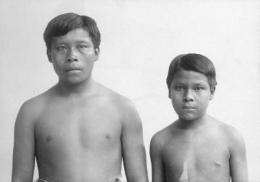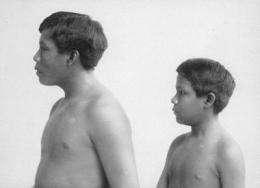Lost images of 'human exhibits' in Britain discovered

A University of Leicester researcher has discovered two photographic images, presumed lost, of native Americans brought to Britain by Roger Casement a century ago.
Dr Lesley Wylie, Lecturer in Latin American Studies in the School of Modern Languages, University of Leicester, made the discovery during her research for a book on the Putumayo, a border region in the Amazon. Her book forms part of the AHRC-funded research project, American Tropics: Towards A Literary Geography, based at the University of Essex.
The photographs were found among a photographic collection relating to the period of the rubber boom in the Putumayo held by the University of Cambridge's Museum of Archaeology and Anthropology.
They depict the subjects naked to the waist against a pale background, in half-length front and profile shots, in accordance with the genre of anthropological photography at that time. The photographs were taken by John Thomson, a pioneering travel photographer and photojournalist, born in Edinburgh.
Dr Wylie, who has published the photographs in the Irish Studies Review described the find as 'very exciting'. She said:

'The photographs essentially reduce the subjects to racial "types": the man and boy are no longer regarded as individuals but as physical specimens supposedly embodying certain racial characteristics. This privileging of the visual was an important feature of British imperial policy of the time. Although the two Amazonians were not British subjects, these photographs can be situated within a tradition of imperial photography which sought to record and document human "types".'
The images have been published as part of a research paper on Roger Casement – remembered as an Irish revolutionary and co-conspirator in the Dublin Easter Rising for which he was hanged in 1916.
Casement made his trip to the Amazon in 1910 and again in 1911 on behalf of the British government to investigate alleged atrocities against the indigenous population. These abuses were allegedly carried out by a Peruvian rubber company owned by British shareholders and relying, partly, on labour from British colonies in the Caribbean. Although undertaken just a few years before Casement was hanged for treason, this trip and his subsequent report confirm both the high regard in which he was held by the British establishment and his commitment to human rights.
Casement brought back more than verbal or written testimony of what he discovered in the Amazon - he arranged to have two 'natives' shipped back so that he could introduce them to leading figures of the British establishment and arrange for them to be painted and photographed.
The two Amazonians were called Omarino and Ricudo. Omarino had been 'presented' to Casement for payment of a pair trousers and a shirt while Ricudo, a married man of 19, had been separated from his wife after Casement 'won him' in a game of cards.
Dr Wylie said that, despite the fact that today these ethnographic photographs strike us as somewhat dehumanising, Casement's decision to commission them would not have been out of the ordinary in 1911; rather, it was consistent with the racial ideology of the time. This in itself is of interest to researchers, since Casement has so often been regarded as resistant to this colonial mindset.
Dr Wylie said: 'I came across the two photographs among a photographic collection held by the University of Cambridge's Museum of Archaeology and Anthropology. Although the catalogue card identified the sitters simply as "Two slaves from Putomayo (sic) river, Up. Amazon, Colombia", I suspected immediately that they were the two Amazonians that Casement had brought to London in 1911. I had previously seen a copy of William Rothenstein's painting of the subjects, and there was a strong resemblance between it and the photographs. Although Casement mentions the existence of these photographs in his personal correspondence, scholars had assumed up to now that these images had been lost.'
Casement's motives, says Dr Wylie, were to raise awareness of the Putumayo atrocities. He wrote in his journal: 'My hope is that by getting some of these unknown Indians to Europe I may get powerful people interested in them and so in the fate of the whole race out here in the toils'.
He also held out hope that what he called the 'paternalistic white man' would save the Putumayo from the plight of slavery to the rubber company: 'Is it too late to hope that by means of [...] humane and brotherly agency something of the good-will and kindliness of Christian life may be imparted to the remote, friendless, and lost children of the forest still waiting the true whiteman's coming into the region of the Putumayo?'
Dr Wylie's research reconstructs the brief period the two Amazonians spent in London in the summer of 1911 and how they were perceived as 'living curiosities' and 'native types'. On 1 August 1911, the two Amazonian youths even made it to the front page of The Daily News. They are reported to have said: "London is very beautiful, but the great river and the forest, where the birds fly, is more beautiful. One day we shall go back."
Dr Wylie adds: 'Whilst it has been possible at least partially to reconstruct the story of Omarino and Ricudo, and their trip from the forests of the Amazon to the busy streets of London, many other stories from the Putumayo, then and now, remain untold.'
'As part of my research I came across testimony given by Omarino and Ricudo recounting stories of violence, displacement, and murder. Today, indigenous communities in the Putumayo, now in the war-torn south of Colombia, are bearing the brunt of the latest tropical boom – in cocaine rather than rubber – as well as ongoing political violence.'
More information: Wylie, Lesley (2010) 'Rare models: Roger Casement, the Amazon, and the ethnographic picturesque', Irish Studies Review, 18: 3, 315-330. DOI: 10.1080/09670882.2010.493024
Provided by University of Leicester

















